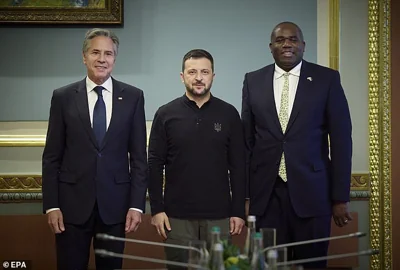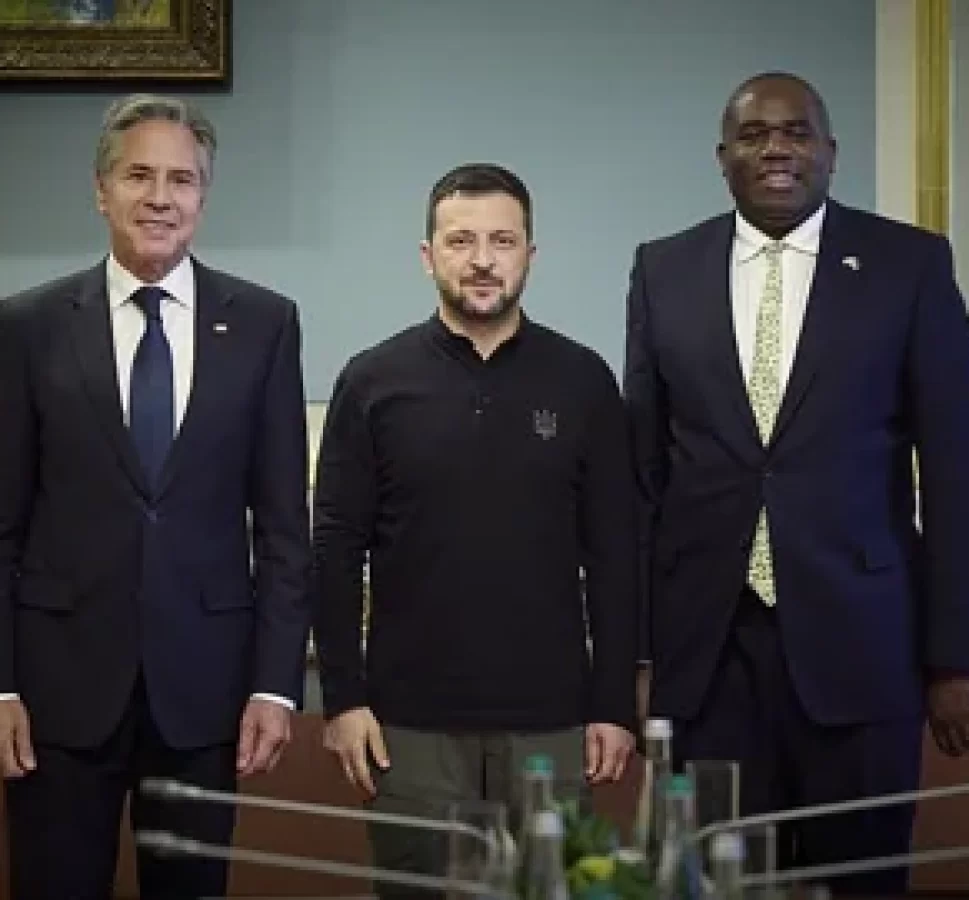
If Washington expands weapons authorisation, NATO will be directly involved in the war, says the Russian leader.
There was a faint glimmer of hope in the past week for Ukraine, that after months of pleading with Washington, it may be starting to move the strategic needle in favour of allowing deep strikes inside Russia using weapons made in the United States.
Until now, the US has allowed Ukraine to use its weapons for counter-battery fire at short range across the border.
When asked if he would lift geographic restrictions, US President Joe Biden on Tuesday told reporters, “we’re working that out right now”.
On the same day, his secretary of state, Antony Blinken, told reporters in London that he and British Foreign Secretary David Lammy “will be listening very intently on this and reporting back,” during a joint visit to Kyiv this week.
Biden and British premier Keir Starmer were to discuss the issue on Friday.
“We have continuously adjusted and adapted based on battlefield conditions,” Blinken said.
House Foreign Affairs Committee Chairman Michael McCaul went further.
He believed Blinken would actually deliver the news to Ukraine that restrictions were lifted.
“What I’ve seen and what I’ve been briefed on, it looks like that’s the message they’re going to give them, that they can use them cross-border,” McCaul said. “It sounded promising to me.”
These statements amounted to a change of tone from Washington, after months of insisting there would be no change in policy – something US defence secretary Lloyd Austin repeated on Friday, saying the 300km-range (185-mile) Army Tactical Missiles Ukraine wants to use inside Russia would not change the course of the war.
Russian President Vladimir Putin on Thursday said that if NATO countries authorised strikes deep inside Russia, they would effectively be involved in the war.
“This is not a question of allowing the Ukrainian regime to strike Russia with these weapons or not. It is a question of deciding whether or not NATO countries are directly involved in a military conflict,” Putin told Russian state TV.
“If this decision is taken, it will mean nothing less than the direct involvement of NATO countries, the United States and European countries in the war in Ukraine. This will be their direct participation, and this, of course, will significantly change the very essence, the very nature of the conflict.”
Western weapons have been used since the beginning of the war to sink Russian ships, strike Russian artillery, down Russian planes and take out Russian tanks.
NATO countries have also provided the Ukrainian armed forces with target co-ordinates. But Putin said NATO personnel would now be programming flight paths into NATO-built missiles, and that marked an escalation.
Would Russia go nuclear?
Western self-restraint has been underpinned by a fear of Russia using nuclear weapons. But on Sunday, CIA director William Burns poured cold water on Moscow’s threats.
“Putin’s a bully. He’s going to continue to sabre-rattle from time to time,” Burns said, seated beside the head of Britain’s MI6 in London during a media event. “We cannot afford to be intimidated by that sabre-rattling.”
Russia had already passed the moment in the war when the usefulness of tactical nuclear weapons was assessed and dismissed, he said.
“There was a moment in the fall of 2022 when I think there was a genuine risk of potential use of tactical nuclear weapons,” Burns said. “I never thought … we should be unnecessarily intimidated by that.”
A successful Ukrainian counteroffensive recaptured at least 8,000 square kilometres (3,090 square miles) from Russian occupiers in the northern Kharkiv region in late August and early September of 2022.
On November 9 that year, as Ukraine rapidly advanced along the Dnipro river, threatening to cut off some 30,000 Russian troops on the right bank, Russia pulled back from 1,170sq km (450sq miles) in the southern Kherson region. Russia also lost more than 700sq km (270sq miles) in the eastern Donetsk region.
General Ben Hodges, a former commander of US forces in Europe, agreed with Burns’ assessment. Ukraine’s counter-invasion of Russia last month could legitimately have triggered a nuclear response in accordance with Russian military doctrine, he told Al Jazeera, but it didn’t.
“Here we are now, two and a half years since the full-scale invasion [of Ukraine] and 10 years since the original invasion by Russia, and we have crossed multiple red lines. Ukraine is inside Russia and Russia is not able to do anything about it,” Hodges said. “So I’m hoping that this will begin to erode some of the excessive fear in the White House and some other capitals.”
Hodges said there was no place along the front line where a nuclear weapon would create an appreciable military advantage to Russia, and said Russians “don’t have the troops that are trained and properly equipped to properly exploit contaminated battlefield”.
In addition, he said, it would isolate Russia diplomatically and economically.
“The Chinese and the Indians have told them not to do it. The US president has said ‘catastrophic consequences’ if you do it,” he said.
“I think the Russians would use a nuclear weapon if it looked like the motherland was about to be destroyed. Like if there was a huge invasion or the threat of a huge invasion by NATO. That’s been their doctrine for the longest time.
“For the Russians, the benefit is continuing to use the threat … this is all intended for Western decision-makers.”
Russian diplomats have issued warnings in recent weeks that the US was reconsidering its restrictive licence on US weapons.
“The West is asking for trouble,” Sergey Lavrov, Russia’s foreign minister, recently said.
Why would the US reconsider?
Ukrainian troops were continuing to fend off intensified Russian attacks in Ukraine’s eastern Donetsk region, but a Russian counterattack in Kursk on Wednesday appeared to be winning back some of the 1,300sq km (500sq miles) Ukraine said it captured in its August 6 counter-invasion.
Geolocated footage suggested that professional Russian forces of the 51st Airborne Regiment retook positions near Zhuravli and Snagost in a mechanised assault.
Ukrainian cities as well as troops remain vulnerable to Russian waves of drone attacks and glide bombs launched from Russian fighter jets. From September 5 to September 10, for example, Russia launched 266 drones and a dozen missiles into areas of Ukraine far from the front line.
Even in Sumy, which had enjoyed a brief period of immunity from air strikes after the Ukrainian counter-invasion, an overnight missile attack on Sumy city on Sunday killed two people and wounded four.
Two days earlier, Russia dropped three glide bombs on the village of Krasnopillia in the Sumy region, killing a woman.
Time is not considered to be on Ukraine’s side, as Russia has greater manpower resources and capacity to manufacture weapons.
And while it lasts, the war is deepening Russia’s ties to its allies, North Korea, Iran and China, who are contributing substantially to its war effort, and receiving sensitive military submarine, space and ballistic technology in return.
Russia to ‘likely’ use Iranian ballistic missiles: Blinken
The Times on Saturday reported that Iran had shipped 200 short-range Fateh-360 ballistic missiles to Russia across the Caspian, citing a Ukrainian intelligence source.
Blinken confirmed that on Tuesday, saying Russia was using the Iranian missiles for targets about 100km (60 miles) from the launch site, saving its own, longer-range missiles for deeper strikes into Ukraine.
“Russia has now received shipments of these ballistic missiles and will likely use them within weeks in Ukraine against Ukrainians,” Blinken said.
Iran agreed to provide Russia with missiles in late 2022, and recent satellite photos have shown that it expanded its production capacity at two sites.
Ukraine’s armed forces have also reported the use of North Korean ballistic missiles in Ukraine for months.
China, too, has stepped up direct military technological assistance to Russia, the US said, a major change from what had been the sale of ambiguous technologies that might have had civilian purposes.
Speaking to reporters on Tuesday, Kurt Campbell, US deputy secretary of state, said China was now selling unambiguously military components to Russia.
“These are component pieces of a very substantial effort on the part of China to help sustain, build and diversify various elements of the Russian war machine,” Politico cited him as saying.
“These are not dual-use capabilities,” Campbell said. “These are basically being applied directly to the Russian war machine.”
In return, Russia was providing high-end military technology, Campbell said. “That has to do with submarine operations, activities of aeronautical design, including stealth; that also involves capacities on missile capabilities.”
North Korea and Iran have also asked for Russian know-how in ballistic missile technology and space technologies.
“Russia is sharing technology that Iran seeks … including on nuclear issues as well as some space information,” Blinken said. North Korea has asked for help in launching satellites into space.
Russia grew prickly over the allegation that it was in collusion with China for war materiel.
“We are building relations with China in a mutually beneficial way, in full compliance with international law and we are not going to give the United States an account,” Russian foreign ministry spokesperson Maria Zakharova told RTVI.
“We hear about a lot of allegations regarding some kind of supplies of some kind of weapons to Russia, but they are groundless,” Kremlin spokesman Dmitry Peskov told journalists.






